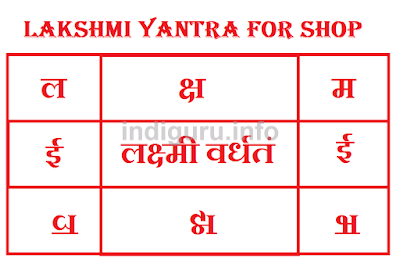This article describes the three most powerful and beneficial Yantras of Goddess Lakshmi for keeping in the purse or pocket, for keeping in the Money Safe, and for hanging in the shop or office. These Hindu Lucky Charms are very effective in quickly increasing the inflow of money, wealth, and prosperity into the home or business.
Lakshmi Yantra to be Kept with Yourself to Get Money and Wealth: This Lakshmi Yantra does not have any Bandhan or Fixed Rules and Restrictions and it can be made by anyone on a small square piece of copper. This Lakshmi Yantra is also readily available in any shop selling Yantras in the Market. Hence, it can be prepared or purchased and sincerely worshiped by offerings of incense, Ghee Diya, flowers, vermilion, and Bhog of sweet eatables.

After worshiping the Lakshmi Yantra, it should be kept in your purse or pocket to please Lakshmi Devi and successfully get plenty of money, wealth, and property.
Akshay Lakshmi Yantra to be worn around the neck or kept in the Safe or Tijori: The meaning of Akshay is unending or everlasting in the context of this Yantra. The rules for making and wearing this Akshay Lakshmi to get tremendous money, wealth, and prosperity are the same as the Lakshmi Yantra described above. The effects, powers, and benefits of this Lakshmi Yantra are also the same.
Lakshmi Yantra to be Kept with Yourself to Get Money and Wealth: This Lakshmi Yantra does not have any Bandhan or Fixed Rules and Restrictions and it can be made by anyone on a small square piece of copper. This Lakshmi Yantra is also readily available in any shop selling Yantras in the Market. Hence, it can be prepared or purchased and sincerely worshiped by offerings of incense, Ghee Diya, flowers, vermilion, and Bhog of sweet eatables.

After worshiping the Lakshmi Yantra, it should be kept in your purse or pocket to please Lakshmi Devi and successfully get plenty of money, wealth, and property.
Akshay Lakshmi Yantra to be worn around the neck or kept in the Safe or Tijori: The meaning of Akshay is unending or everlasting in the context of this Yantra. The rules for making and wearing this Akshay Lakshmi to get tremendous money, wealth, and prosperity are the same as the Lakshmi Yantra described above. The effects, powers, and benefits of this Lakshmi Yantra are also the same.
Lakshmi Yantra for Shop, Office, or Business Place: This Lakshmi Yantra will increase money flow, turnover, and profits of the business and will make it healthy and prosperous. This Lakshmi Yantra should be prepared on Monday and worshiped in the same way as the two Yantras described above.
The Lakshmi Yantra should be made on Bhojpatra or Paper with Ashwagandha Paste and put inside a photo frame or laminated and hung on the wall above the cash counter or the wall facing the main entrance of the shop or business premises.


Comments
Post a Comment